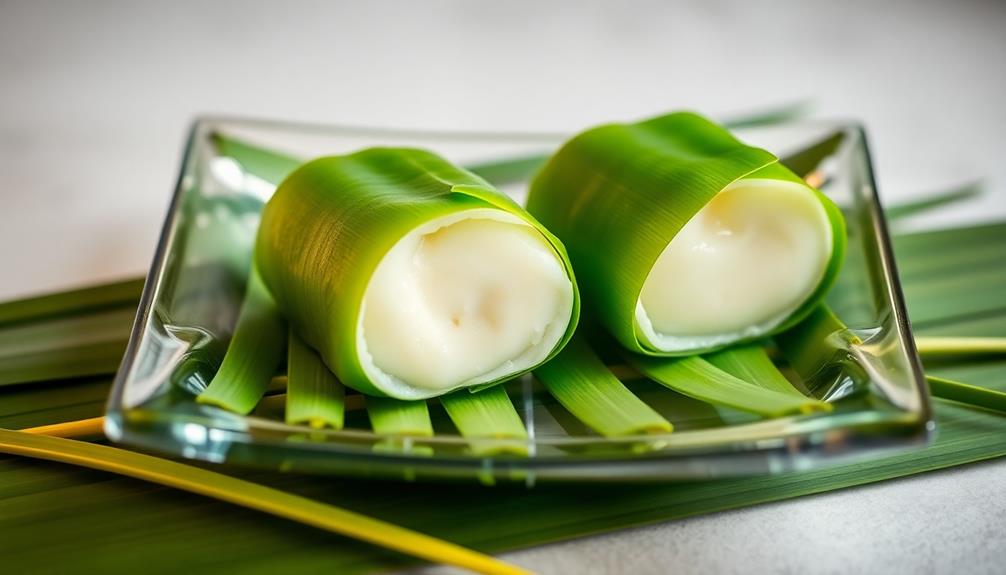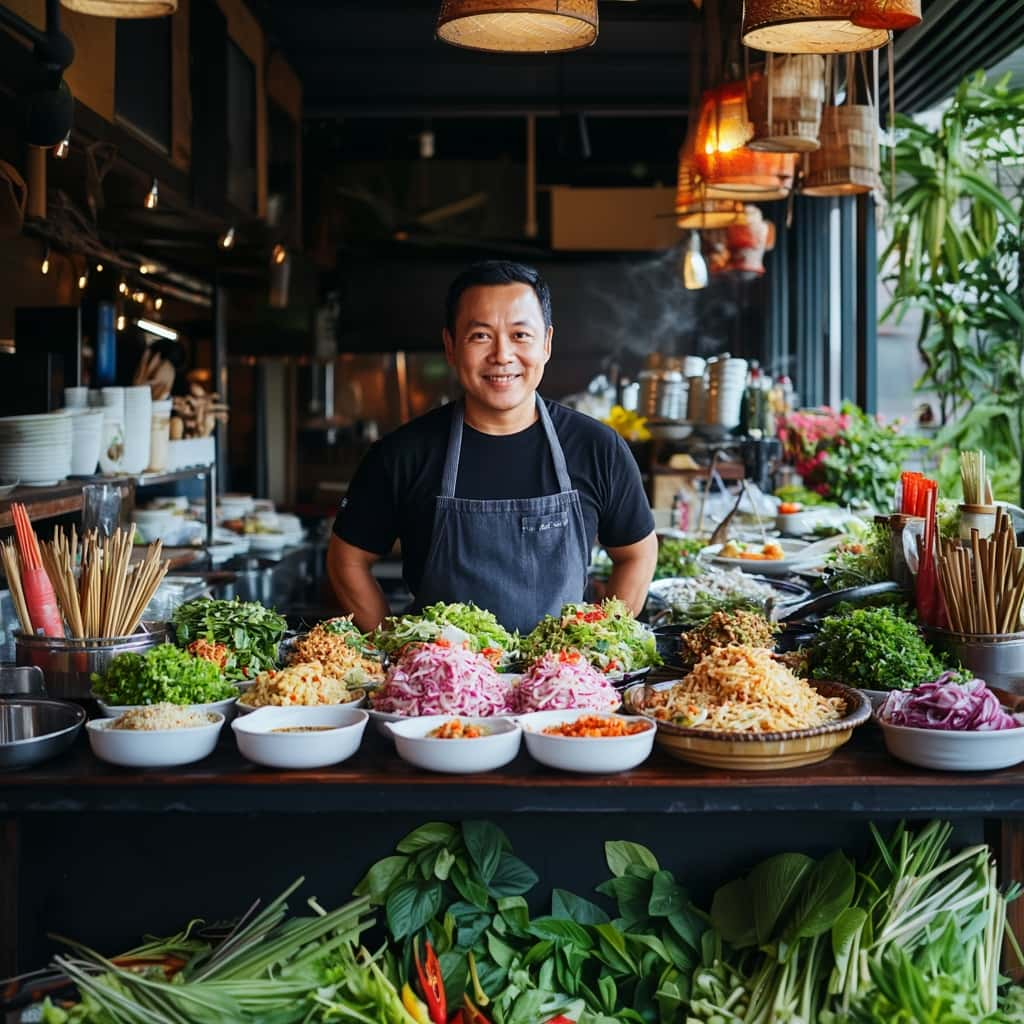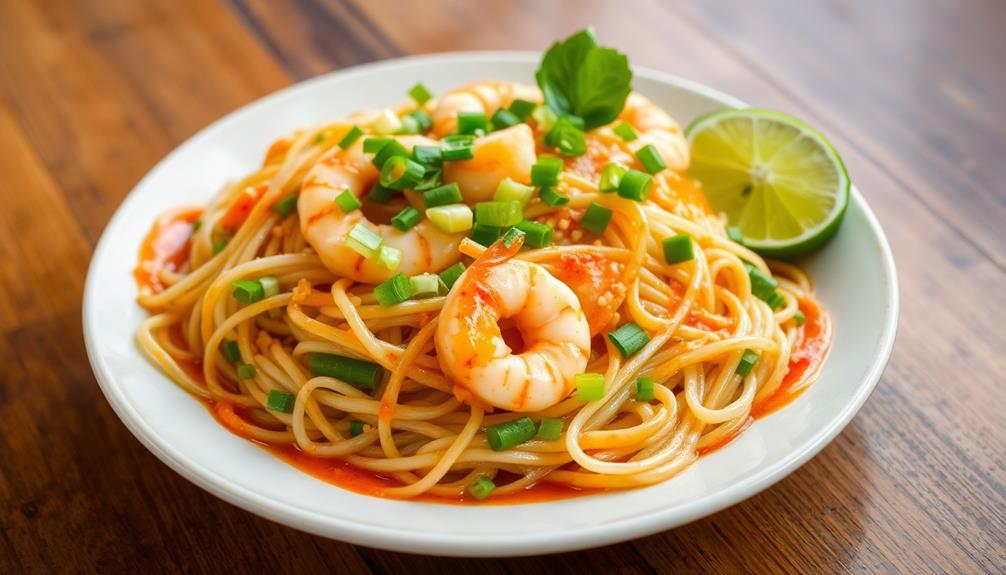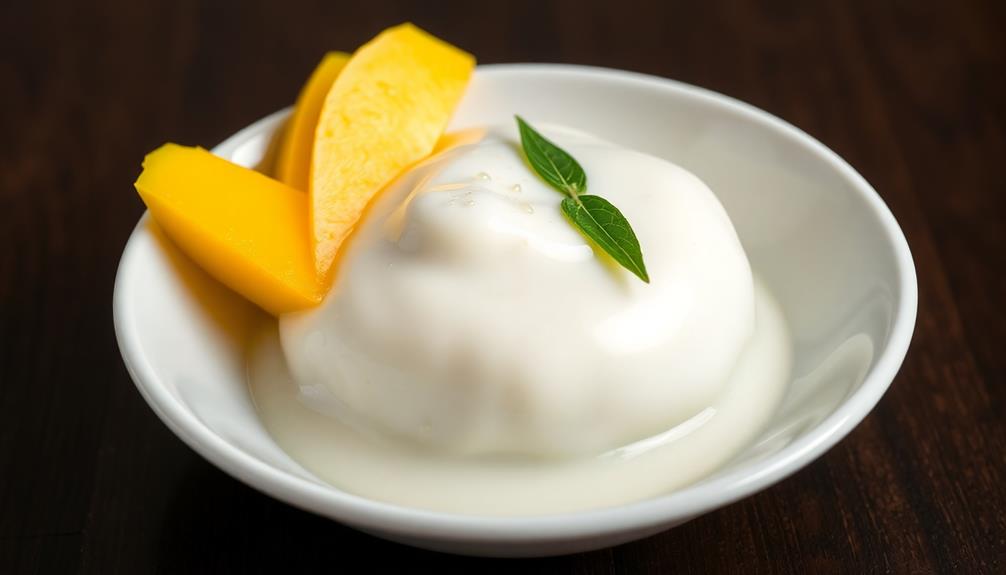Pandan leaf wrapped desserts are a beloved Southeast Asian treat you'll adore! Originating from the region, these fragrant parcels feature a vibrant green hue and aromatic filling made with glutinous rice flour, coconut milk, and sugar. The key is mastering the delicate wrapping technique, then steaming to perfection. Customize the tasty stuffing with local fruits and nuts to suit your preferences. These desserts symbolize hospitality and are often enjoyed during special occasions, showcasing the rich culinary heritage. With their captivating visuals and mouthwatering flavors, it's no wonder these delightful treats have been cherished for generations. Let's dive deeper into the world of pandan leaf wrapped desserts!
Key Takeaways
- Pandan leaf wrapped dessert is a traditional Southeast Asian delicacy, known for its aromatic pandan leaves, sweetened coconut milk filling, and distinct presentation.
- The dessert's preparation involves soaking and wrapping pandan leaves, creating a soft, steamed, and visually appealing treat that is often served during festivals and special occasions.
- The filling is a sweet, pudding-like mixture of coconut milk, sweetened condensed milk, and pandan extract, which can be customized with local fruits and nuts.
- Careful attention to the wrapping technique and steaming process is crucial for maintaining the dessert's texture, flavor, and moisture.
- The pandan leaf wrapped dessert represents the rich cultural heritage and culinary traditions of Southeast Asia, reflecting hospitality and sharing among family and friends.
History
Pandan leaf's storied history dates back centuries, intertwined with the vibrant culinary traditions of Southeast Asia. This aromatic, tropical plant has long been revered for its versatility, lending its distinctive flavor and vibrant green hue to a wide array of sweet and savory dishes.
In Thailand, the pandan leaf has been a staple ingredient in the country's rich dessert heritage, with recipes for pandan-infused delicacies passed down through generations.
The pandan leaf's journey extends beyond the kitchen, as it has also played a significant role in cultural and religious practices throughout the region. In Malaysia, the leaves are often used in ceremonial offerings, while in Indonesia, they're woven into intricate decorations for special occasions.
This multifaceted plant has truly become a beloved part of the Southeast Asian culinary and cultural tapestry, its story a testament to the enduring power of local traditions and ingredients.
Recipe
Pandan leaves are a common ingredient in Southeast Asian cuisine, known for their distinct aroma and flavor. These fragrant leaves are often used to infuse desserts with a delightful green hue and a subtle, sweet taste.
In this recipe, we'll be showcasing the versatility of pandan leaves by creating a delightful wrapped dessert. This dessert is a delicate balance of textures and flavors, perfect for satisfying your sweet cravings.
Ingredients:
- 1 cup glutinous rice flour
- 1/2 cup coconut milk
- 1/4 cup white sugar
- 1/4 teaspoon salt
- 12-15 fresh pandan leaves, washed and dried
Cooking Instructions:
In a mixing bowl, combine the glutinous rice flour, coconut milk, sugar, and salt. Knead the mixture until it forms a smooth, pliable dough.
Divide the dough into 12-15 equal portions. Take a pandan leaf and place one portion of the dough in the center. Fold the leaf around the dough, creating a tightly wrapped packet.
Repeat this process with the remaining dough and pandan leaves.
Tips:
When selecting pandan leaves, look for ones that are bright green and free of blemishes. If the leaves are dried or discolored, they may impart a bitter flavor to the dessert.
Additionally, be sure to tightly wrap the dough in the pandan leaves to prevent the filling from leaking during the cooking process. Serve these pandan-wrapped treats warm for the best flavor and texture experience.
Cooking Steps
First, soak the pandan leaves in water to soften them.
Then, prepare the pandan leaf casings by carefully shaping the leaves into small cups.
Next, mix together the pandan leaf filling ingredients and stuff the prepared leaf casings with the mixture.
Step 1. Soak Pandan Leaves in Water
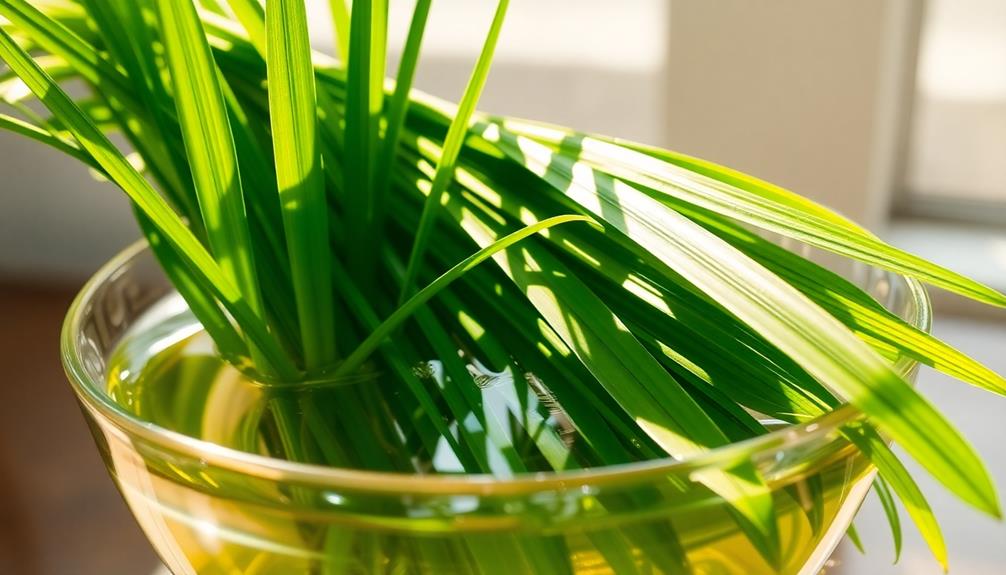
To begin, soak the pandan leaves in a bowl of water for about 30 minutes. This will help soften the leaves and make them more pliable. You'll want to use fresh, vibrant pandan leaves for the best results.
Once submerged, the leaves will turn a deeper green color and become more supple.
After the soaking time, gently remove the leaves from the water one by one. Avoid wringing or squeezing them, as this can damage the delicate structure.
Lay the leaves flat on a clean surface, arranging them in an overlapping pattern. This will make it easier to wrap them around the filling later on.
Be sure to save the pandan-infused water – you'll use it to moisten the rice flour mixture. The fragrant liquid will help enhance the overall flavor and aroma of your homemade Kanom Bai Toey.
With the pandan leaves prepped, you're now ready to move on to the next step: making the coconut filling.
Step 2. Prepare Pandan Leaf Casings

With the pandan leaves prepped, you can start preparing the leaf casings. Take each leaf and lay it flat on a clean surface. Gently fold the leaf in half lengthwise, creating a nice crease down the center.
Then, roll the leaf tightly, starting from the stem end and working your way to the tip. Secure the roll by tying a small piece of kitchen string around the center. Don't wrap too tightly, or the leaf may tear.
Next, use a sharp knife to trim off any ragged edges on the ends of the leaf casings. You want them to have clean, even edges.
Repeat this process with the remaining pandan leaves until you have enough casings for your recipe. Be mindful not to tear or puncture the delicate leaves.
With careful handling, you'll have a lovely set of pandan leaf containers ready to be filled. The key is to work slowly and gently to preserve the leaf's natural flexibility and shape.
Step 3. Mix Pandan Leaf Filling

Now that you have your pandan leaf casings ready, let's move on to mixing the pandan leaf filling. In a medium-sized bowl, combine the sweetened condensed milk, coconut milk, and pandan extract. Stir the ingredients together until they're fully incorporated and the mixture is smooth.
Next, add the tapioca flour and whisk vigorously to prevent any lumps from forming. The filling should have a thick, pudding-like consistency.
If the mixture seems too thin, you can add a bit more tapioca flour, a teaspoon at a time, until you reach the desired texture. On the other hand, if it's too thick, simply stir in a splash of coconut milk to thin it out. Be sure to taste the filling and adjust the sweetness to your liking by adding more pandan extract or a touch of sugar.
Once the filling is ready, you can start assembling your pandan leaf-wrapped desserts. Scoop a small amount of the filling into the center of each pandan leaf casing and gently wrap the leaves around the filling.
Step 4. Stuff Pandan Leaf Casings With Filling
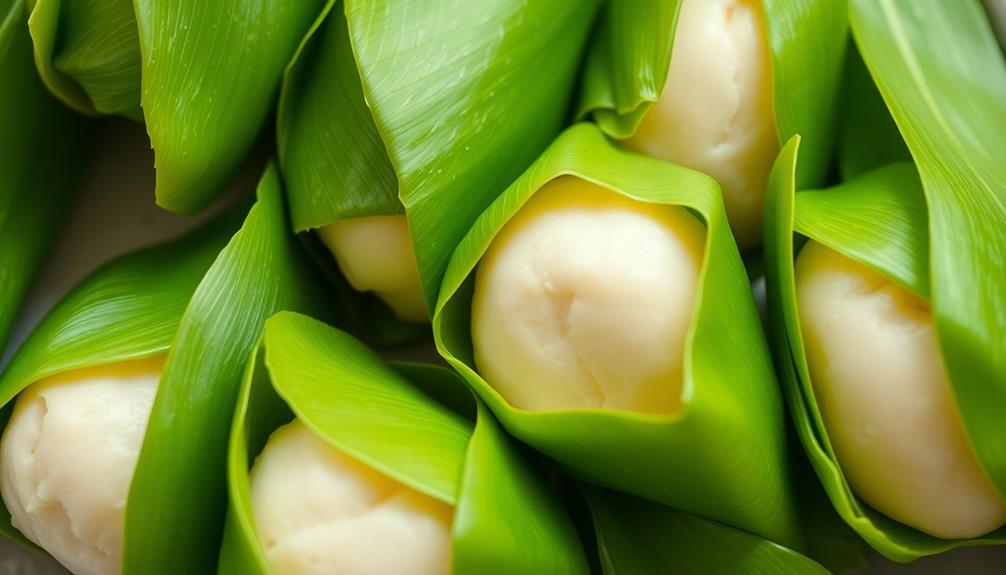
Once you've mixed the pandan leaf filling, it's time to start assembling your desserts.
Carefully unroll each pandan leaf, making sure not to tear them. Scoop a small amount of the filling – about a tablespoon – and place it near the base of the leaf. Gently fold the sides of the leaf over the filling, then continue rolling it up tightly to encase the filling completely. Secure the rolled leaf with a small toothpick or skewer.
Repeat this process with the remaining pandan leaves and filling until you've used it all up.
Arrange the stuffed pandan leaves on a serving plate or in a steamer basket. Steam the desserts for 10-15 minutes, or until the leaves are tender and the filling is heated through.
Serve the pandan leaf wrapped treats warm, garnished with a sprinkle of toasted coconut or a drizzle of sweet coconut sauce, if desired.
Enjoy the fragrant, flavorful combination of the pandan leaf and the rich, coconut-y filling.
Step 5. Steam Pandan Leaf Parcels

To steam the pandan leaf parcels, first place them in a steamer basket. Be sure not to overcrowd the basket, as you'll want the parcels to have enough room to steam properly.
Fill the bottom of your steamer with water, bringing it to a gentle boil over medium heat. Once the water is simmering, carefully lower the basket into the steamer. Cover with a lid and let the parcels steam for about 15-20 minutes, or until they're heated through and the filling is warm.
Keep an eye on the water level, topping it up as needed to ensure it doesn't boil dry.
When the time's up, use tongs to carefully remove the hot parcels from the steamer. Place them on a serving plate and let them cool for a minute or two before enjoying.
The pandan leaf should be fragrant and the filling warm and inviting. Savor each delectable bite of this traditional Thai dessert.
Final Thoughts
The pandan-wrapped dessert has delighted your taste buds, leaving a lasting impression. While the process of assembling these delicate parcels may have seemed daunting at first, you've now mastered the technique. The fragrant pandan leaves, combined with the sweet, sticky filling, create a truly unique and satisfying experience.
As you savor the final bite, take a moment to appreciate the thoughtful attention to detail that went into crafting this traditional Thai treat. The pandan's vibrant green hue and captivating aroma elevate the dessert, making it a feast for the senses. That level of dedication and precision are evident in every bite, from the perfectly cooked sticky rice to the creamy coconut milk infusion. The skillful blending of these flavors and textures creates a truly unforgettable experience. And if you’re curious about recreating this delectable dish at home, look no further than the traditional khao lam recipe. This timeless recipe has been passed down through generations, ensuring that each batch is prepared with the same love and care that has made it a beloved Thai delicacy.
Moving forward, you can experiment with different fillings, perhaps incorporating local fruits or nuts, to put your own spin on this classic dish. Embrace the joy of sharing this pandan-wrapped delight with family and friends. Its enchanting presentation and delectable flavors are sure to impress and delight all who taste it.
Savor each moment, for the pandan leaf's magic has the power to transport you to the heart of Thai culinary tradition.
Frequently Asked Questions
How Long Do Kanom Bai Toey Typically Last Before Spoiling?
How long a dessert lasts before spoiling depends on several factors, like its ingredients and storage conditions. With proper refrigeration, most homemade desserts can maintain their freshness for 3-5 days, though some may last a bit longer.
Can Kanom Bai Toey Be Frozen for Later Consumption?
You can freeze these desserts for later enjoyment. Wrap them tightly in plastic or foil to prevent freezer burn, and they'll keep for up to 2-3 months. Just thaw at room temperature before serving.
What Are the Common Fillings Used in Kanom Bai Toey?
The common fillings used in this dessert often include sweetened mung bean paste, sweetened shredded coconut, or sweet sticky rice. Depending on the recipe, you might also find fillings made with taro, jackfruit, or other tropical ingredients.
Is Kanom Bai Toey Suitable for People With Dietary Restrictions?
Yes, it can be suitable for people with dietary restrictions. The fillings can be adjusted to accommodate various dietary needs, such as using dairy-free or gluten-free ingredients. Just be sure to check the specific ingredients used.
Where Can I Purchase Pre-Made Kanom Bai Toey if I Don't Want to Make Them?
If you don't want to make them yourself, you can find pre-made kanom bai toey at Thai specialty grocery stores or online Thai food marketplaces. Many offer convenient pre-packaged options for those who prefer not to prepare them from scratch.
